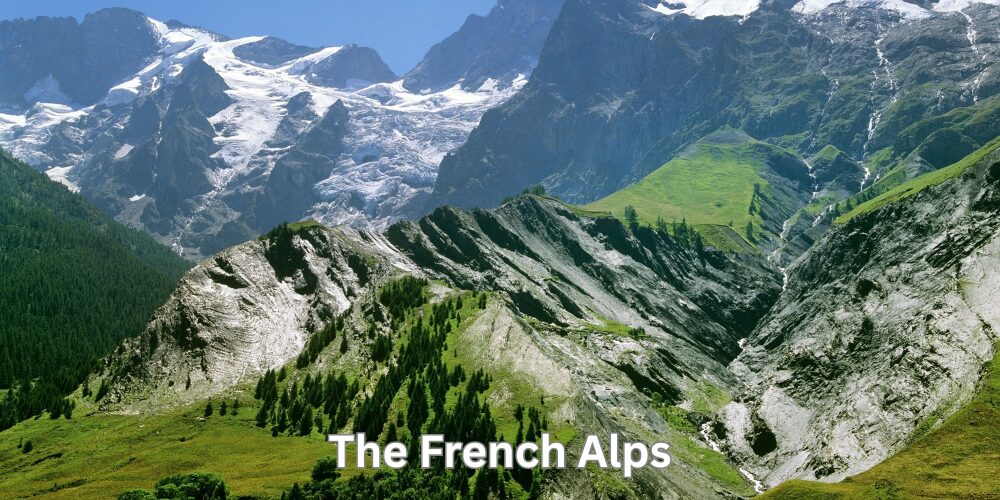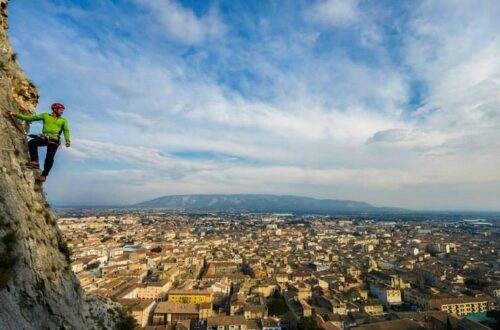Via Ferrata de Saint-Hilaire-du-Touvet: Climbing the Cliffs of the Chartreuse
In the heart of the French Alps, the Via Ferrata de Saint-Hilaire-du-Touvet is one of the most thrilling climbing experiences in southeastern France. Nestled within the Chartreuse Massif, this via ferrata is a spectacular route with tough verticality. It has stunning views over the Grésivaudan Valley and a direct connection to the region’s deep alpine character.
Just 30 minutes from Grenoble, the route attracts climbers, adventurers, and thrill-seekers from across Europe. Its reputation for technical difficulty and exhilarating exposure makes it a favorite among experienced via ferratists—but it also offers shorter options for those less familiar with vertical rock.

A Legendary Cliff in the Alps
The Via Ferrata de Saint-Hilaire-du-Touvet scales the towering cliffs beneath the plateau of Saint-Hilaire, a small mountain village perched more than 1,000 meters above the valley floor. The route ascends part of the Massif de la Chartreuse. It is a dramatic karst landscape characterized by vertical limestone walls, deep ravines, and lush alpine forests.
Click here to read about a selection of amazing adventures in Europe.
One of the area’s defining features is the Funiculaire de Saint-Hilaire, a historic funicular railway that dates back to the early 20th century. It once served as a route for patients to reach the village’s tuberculosis sanatoriums, and it still climbs the cliff face today, now used by paragliders and tourists. As you ascend the via ferrata, you’ll often see gliders soaring overhead, adding to the high-mountain ambiance of the route.
Route Description of The Via Ferrata de Saint-Hilaire-du-Touvet
The via ferrata has three main sections, each with its own character and level of difficulty. The full route is rated “TD” (Très Difficile)—very difficult—and is for those with good strength, solid footing, and prior via ferrata experience. However, climbers can choose to exit after the first or second section, making the route more accessible.
Section 1: The Balcon des Myrtilles
- Difficulty: Moderate (AD to D)
- Duration: ~30 minutes
This initial section is the most approachable and offers an excellent introduction to the route. Climbers traverse horizontal ledges and gently inclined walls equipped with iron rungs, cables, and footpegs. The path hugs the cliffside, offering magnificent views over the valley and Grenoble far below.
You need to be in good shape for Via Ferratas. Click here to turbocharge your health and fitness.
This section is ideal for beginners or those who want a taste of the experience without committing to the more strenuous climbs ahead. There’s an escape route at the end of this section for those who wish to descend via a hiking path.
Section 2: The Dièdre aux Écureuils
- Difficulty: Difficult (D+ to TD)
- Duration: ~45 minutes
This section introduces more technical and vertical climbing. Climbers ascend steep dihedrals (corner cracks) and navigate narrow traverses, with more exposed positions. The rock is solid, and the via ferrata equipment is well-maintained, but the route becomes significantly more demanding.

Arm strength and balance are key here, especially on vertical pitches where foot placements are spaced out. The reward is the sense of height and the ever-expanding panorama—on clear days, Mont Blanc is even visible on the horizon.
Section 3: Le Grand Dièdre
- Difficulty: Very Difficult (TD)
- Duration: ~45 minutes to 1 hour
The final section is the route’s crown jewel—and also its most physically and mentally demanding. It features a long, vertical dihedral climb with sparse footholds, overhangs, and an intense feeling of exposure. This is not a section for the faint-hearted or the inexperienced. Climbers are constantly on the edge, both physically and metaphorically, as they push upward with the valley yawning open behind them.
Click here to read about an unforgettable adventure in Europe, spanning four countries.
Those who complete this section are rewarded with one of the most exhilarating finishes in the region—emerging onto the plateau with views that stretch for miles and a profound sense of accomplishment.
Scenic Beauty and Vertical Exposure
The Via Ferrata de Saint-Hilaire-du-Touvet is as much about vertical drama as it is about natural beauty. As you climb, the landscape unfolds beneath you with dense forests carpeting the valley floor, the Isère River snaking through the Grésivaudan, and the snow-capped summits of the Belledonne range in the distance.
The exposed nature of the route means the views are almost constant. Unlike many alpine via ferratas that weave through gorges or forested cliffs, this one remains open and airy from start to finish. It offers a continuous visual connection to the high peaks and deep valleys of the Alps.
It’s also common to see paragliders launching from the top of the cliffs—Saint-Hilaire is a world-renowned paragliding site, and their colorful sails add an extra dimension to the already spectacular backdrop.
Click here to see a range of stylish, practical and outdoor appropriate menswear.
Practical Information
- Starting Point: The route begins from the Les Petites Roches area. You can park at the base in Lumbin and take the funicular up, or park near the top and descend via trails after completing the route.
- Best Time to Climb: Late spring to early autumn (May to October). The route can be slippery after rain and is not recommended in wet or icy conditions.
- Equipment Needed:
- Certified via ferrata lanyard with energy absorber
- Climbing harness
- Helmet
- Gloves (recommended for gripping cables and rungs)
- Sturdy shoes with good grip (approach or hiking shoes)
Accessibility and Options
While the full route is best suited for experienced climbers, the modular design allows visitors to attempt only the first or second section, making it possible to tailor the challenge to your comfort level. Signage along the route provides information about escape points and level of difficulty.
For families or those with limited time, the Balcon des Myrtilles offers a rewarding experience in its own right, combining adventure with scenic rewards without requiring technical prowess.
Click here to read about another Via Ferrata adventure in France.
More Than Just a Climb
Beyond the physical challenge, the Via Ferrata de Saint-Hilaire-du-Touvet is also a gateway to exploring one of France’s lesser-known alpine regions. The Chartreuse Massif is steeped in history and tradition. It’s the birthplace of Chartreuse liqueur, made by Carthusian monks in nearby Voiron, and its quiet trails and villages are a haven for hikers, nature lovers, and seekers of peace.
After your climb, stop at one of the rustic inns or cafés in Saint-Hilaire or Saint-Bernard-du-Touvet for a hearty alpine meal. The region’s pastoral charm and relaxed atmosphere make it a perfect place to unwind after the day’s vertical adventure.
Final Thoughts
The Via Ferrata de Saint-Hilaire-du-Touvet is more than just a sport route—it’s an experience that combines physical challenge and cultural flavor into one unforgettable journey. You could climb just the first section or conquer the full route. You’ll still walk away with your adrenaline pumping and your soul stirred by the epic beauty of the Chartreuse.
For those who dream of climbing high cliffs with nothing but air and alpine wind below, this is one of the finest via ferratas France has to offer.

